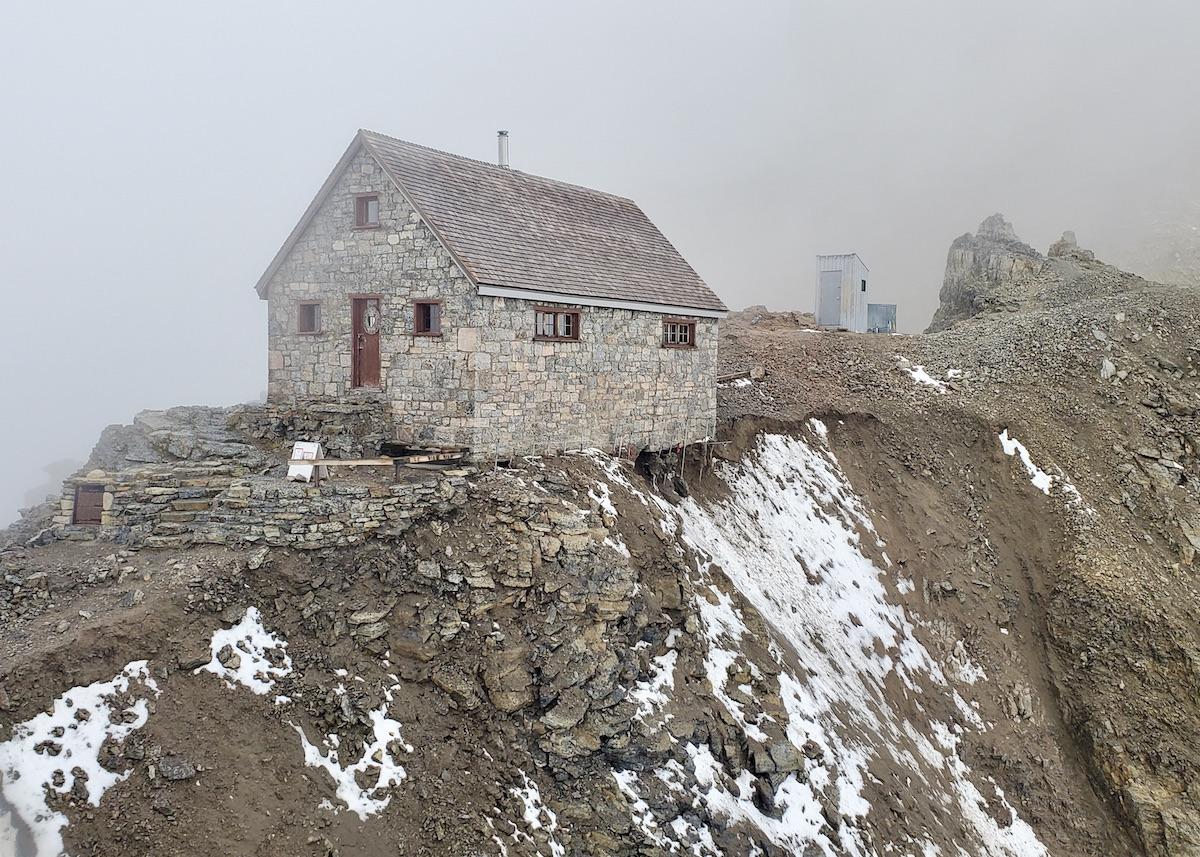
It's no longer safe for hikers and mountaineers to use the Abbot Pass Refuge Cabin National Historic Site/Parks Canada
Climate change challenges will force Parks Canada to dismantle an iconic stone alpine shelter just before it turns 100.
The Abbot Pass Refuge Cabin National Historic Site, better known as the Abbot Pass Hut, is no longer safe as slope erosion and glacial recession have caused structural damage despite extensive stabilization efforts and interventions.
“Parks Canada recognizes the importance of the Abbot Pass Hut to many Canadians, particularly those in the climbing and alpine community, and is saddened by the loss of this treasured alpine refuge due to the effects of climate change,” the agency said in a news release. It couldn't find a way to conserve the cabin or safely move it.

Only expert hikers and mountaineers have been able to reach the historic hut in the past/Parks Canada
"It's a sad day for us all here today," Rick Kubian, superintendent of the Lake Louise, Yoho and Kootenay Field Unit, said at a virtual news conference to explain the unusual move of dismantling a national historic site. The Abbot Pass will remain closed until the removal work is done in late spring or early summer, but the hope is to reopen the area before the summer visitor season.
The historic hut is at 2,925 metres (9,600 feet) above sea level on the continental divide between Lake O’Hara in Yoho National Park (British Columbia) and Lake Louise in Banff National Park (Alberta). It’s a challenging four- to five-hour hike one way and reservations and helmets are mandatory. The hut is perched on a narrow col (ridge) between Mount Victoria and Mount Lefroy, and the final approach climbs 460 metres (1,500 vertical feet) on a steep and loose scree slope.
The hut was built in 1922 by Swiss-born mountain guides who came to Canada in 1899 to work for the Canadian Pacific Railway. According to a plaque at the site, "it was patterned on examples in the Swiss Alps." Other than the stone for the walls, construction materials were packed by horses to the foot of the Victoria Glacier and then carried by mountaineers to the pass summit.
"Never again was such an arduous feat undertaken in the national parks," the plaque says. "The shelter has served as a high-altitude base for generations of climbers, here in the cradle of Canadian mountaineering."
The Alpine Club of Canada has operated the hut since 1985 as a popular summer destination for advanced hikers and a base for mountaineers planning to summit Mount Lefroy or Victoria. "It breaks our hearts even more to see the retirement of the hut just shy of its centennial anniversary, and we suspect we're not alone in that sentiment," the club said in a blog post, while asking people to share their memories on social media using the hashtag #AbbotPassLove.
The hut was designated a national historic site in 1992 for its rustic architecture, representation of the theme of alpine recreation in Canada, and historic use in mountaineering.
When the hut was built, the southeast slope was covered by "permanent snow and ice, protecting the underlying rock and soil from erosion,” Parks Canada said. “Since then, the snow and ice have receded exposing the steep, unconsolidated slope below the hut to thawing and surface water erosion.”
When erosion and rockfall were first noted in 2016, Parks Canada conducted geotechnical assessments and monitored the slope for stability.
Significant slope stabilization work was done in 2018, when the hut was closed to visitors. More than $600,000 Canadian ($470,000 USD) was spent to install rock anchors on the slope.
“The remote location made this work extremely challenging,” Parks Canada said. “The elevation of Abbot Pass reduces the amount of weight that helicopters can carry when bringing material and equipment to the site, and suitable weather and ground conditions exist for only a few weeks each year.”

Parks Canada tried to save the Abbot Pass Hut/Parks Canada
Work was cancelled in 2019 due to bad weather and again in 2020 due to the pandemic.
Record high temperatures at the pass in 2021 contributed to further erosion of the slope and began impacting the hut itself. About 114 cubic metres of material fell from the slopes under the hut, prompting Parks Canada to immediately conduct a second geotechnical assessment. The new assessment found a higher than anticipated rate of permafrost thaw and higher levels of slope erosion than previously predicted. It discovered new evidence, including cracks in the masonry, that the entire hut has been impacted by slope erosion.
“The 2018 assessment likely overestimated the amount of bedrock under the foundation of the hut,” Parks Canada concluded. “Based on these findings it is highly unlikely that additional slope stabilization efforts would preserve the hut in its current location.”

It's the end of an era for the Abbot Pass Hut/Parks Canada
Parks Canada considered deconstructing the hut so it could be rebuilt at Abbot Pass or somewhere else. But unstable hut and slope conditions mean that “the delicate work required for this type of removal would pose too great a risk to the health and safety” of staff and contractors. Historical masonry experts advised that the type of construction material (primarily limestone) is likely to fracture if moved.
The hut will soon be “substantially removed," meaning the limestone sourced in the area may stay but everything else will be taken away. Parks Canada has already completed a "thorough heritage recording" of the site that includes a video recording. It plans to save some hut material for future commemorations, but couldn't say what that might look like or where it might be.
Parks Canada promises to consult with Indigenous groups, the Alpine Club, stakeholders and the public to come up with a commemoration plan.

 Support Essential Coverage of Essential Places
Support Essential Coverage of Essential Places




Add comment